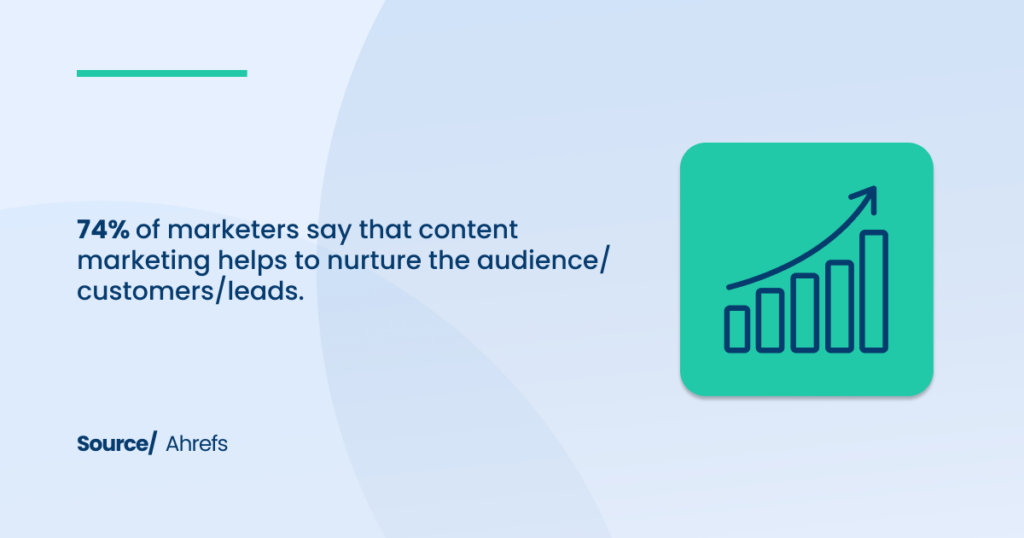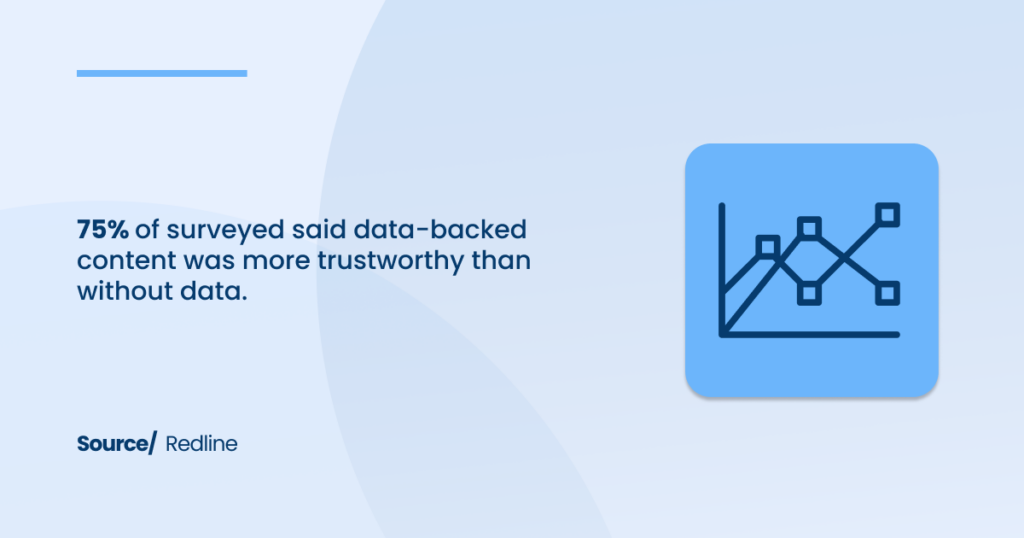If you walk into a busy market where every stall offers a new financial tool, each promises to make managing your money easier.
With so many options, how can one fintech company stand out and grab your attention?
The key isn’t just having the latest technology or the best ideas—it’s using smart content marketing.
87% of marketers report that content marketing generates demand/leads.

In today’s fintech world, content marketing does more than just advertise. It helps educate customers, build trust, and inspire new ideas.
By creating helpful blogs, engaging videos, and interesting social media posts, fintech companies can connect with people.
A reliable FinTech marketing agency will help you define clear actions.
In this post, we’ll explore how effective content marketing is fueling the next wave of innovation and helping fintech companies thrive.
What’s Fintech Got to Do with Content?
Fintech, short for financial technology, is revolutionizing how we handle money.
From mobile banking apps to blockchain-based transactions, FinTech is about leveraging technology to make financial services more efficient, accessible, and user-friendly.
On the other hand, content marketing involves creating and sharing valuable, relevant content to attract and engage a specific audience, ultimately driving profitable customer actions.
When you combine fintech with content marketing, you create a powerful synergy that can transform your business.
Content marketing for fintech isn’t just about promoting products; it’s about educating your audience, building trust, and establishing your brand as an authority in the financial ecosystem.
In a world where fintech trends are constantly evolving, having a robust content strategy ensures that your business stays relevant and competitive.
Define Fintech and Content Marketing
Fintech encompasses various applications, including digital payments, online lending, robo-advisors, and cryptocurrency platforms.
These innovations simplify financial transactions, enhance user experiences, and expand access to financial services for individuals and businesses alike.
Conversely, content marketing focuses on creating informative and engaging content—such as blogs, videos, infographics, and social media posts—that resonates with your target audience.
The goal is to provide value, solve problems, and guide potential customers through their buyer’s journey, from awareness to decision-making.
Explain the Synergy Between the Two Industries
The synergy between fintech and content marketing lies in their mutual ability to drive industry innovation and growth.
- Education and Simplification: Fintech solutions can be complex and intimidating. You can break down these complexities into easily understandable information through content marketing for fintech. Educational content helps demystify financial products and services, making them more accessible to a broader audience.
- Building Trust and Credibility: In the financial sector, trust is paramount. Consistently providing high-quality, transparent content positions your fintech brand as a reliable and knowledgeable player. This trust is essential for customer acquisition and retention, especially in B2B fintech marketing, where businesses seek dependable partners.
- Establishing Thought Leadership: By sharing insights on the latest fintech trends, emerging technologies like fintech AI, and industry best practices, your brand can become a thought leader. This authority attracts potential customers and fosters a community of engaged and loyal followers.
- Driving Lead Generation and Conversion: Strategic content marketing attracts potential leads by addressing their pain points and offering solutions. Well-crafted content guides prospects through the sales funnel, increasing fintech lead generation and improving conversion rates.
- Enhancing SEO and Digital Presence: High-quality content optimized for search engines boosts your online visibility. By targeting relevant keywords such as fintech content marketing, fintech marketing agencies, and fintech branding, you can improve your search rankings and drive organic traffic to your website.
Fintech marketing strategies incorporating effective content marketing can significantly enhance your brand’s presence, credibility, and growth potential within the fintech ecosystem.
The Trust Factor: Building Credibility in Fintech
In fintech, trust is the cornerstone of success.
Unlike traditional financial institutions, fintech companies often operate without physical branches, relying entirely on digital platforms to deliver their services.
This digital-first approach necessitates an unwavering focus on building and maintaining trust with your audience.
Why Trust is Paramount in Financial Services
Financial transactions involve sensitive information and significant financial stakes.
Whether you’re handling personal banking, investment portfolios, or business loans, your customers must feel confident that their data is secure and their money is safe.
According to a 2023 Global Report, 97% of marketers have found success with content marketing, and a substantial portion of this success is tied to trust-building initiatives.
Source: HubSpot
Without trust, even the most innovative fintech solutions can struggle to gain traction.
Customers are hesitant to switch from traditional banks to new digital platforms unless they are convinced of the reliability and security of these services.
Therefore, establishing trust is both beneficial and essential for fintech lead generation and long-term success.
How Content Marketing Establishes and Maintains Trust
Content marketing for fintech is pivotal in building trust by providing transparent, accurate, and valuable information.
- Educational Content: By creating content that explains how your fintech solutions work, you help demystify complex financial concepts. Educational blogs, tutorials, and webinars empower your audience with knowledge, making them feel more comfortable and confident in your offerings.
- Transparency: Sharing detailed information about your company’s practices, security measures, and compliance with regulations fosters transparency. Customers’ trust in your brand deepens When they understand how you protect their data and ensure secure transactions.
- Thought Leadership: Publishing insightful articles on fintech trends and the future of financial technology positions your brand as an authority. Customers perceive your company as knowledgeable and reliable when you consistently provide valuable insights.
- Customer Testimonials and Case Studies: Showcasing real-life success stories and positive customer experiences builds credibility. Testimonials and case studies are social proof, demonstrating that your fintech solutions deliver tangible benefits.
- Consistent Communication: Regularly updating your audience with the latest news, updates, and helpful tips through newsletters and social media keeps your brand top-of-mind. Consistent communication reinforces trust by showing you are active, engaged, and committed to your customers’ success.
Educate to Innovate: Empowering Your Audience with Knowledge
In the fast-paced world of fintech, complexity is often the norm.
From blockchain technology to AI-driven financial solutions, the jargon and intricate processes can be overwhelming for both potential customers and stakeholders. This is where fintech content marketing shines by transforming these complexities into clear, understandable information.
You explain blockchain to someone without a technical background.
Through well-crafted content, you can break down sophisticated concepts into relatable terms.
Blogs, infographics, and video tutorials are essential tools to demystify fintech innovations, making them accessible to a wider audience.
Source: SEMrush
For instance, a blog post titled “Blockchain Made Simple: How It’s Changing Financial Transactions” can provide a straightforward explanation highlighting the benefits without getting bogged down in technical details.
Educational Content Types: Blogs, Webinars, Tutorials
Different types of educational content cater to various learning preferences, ensuring your message reaches a diverse audience:
- Blogs: Regularly updated blogs can cover a wide range of topics, from the basics of digital payments to advanced AI applications in finance. Long-form content allows for in-depth exploration, positioning your brand as a thought leader in fintech.
- Webinars: Interactive webinars offer a platform for real-time engagement. Hosting sessions like “Future of Fintech: Trends to Watch in 2025” allows you to share insights and answer questions, fostering a deeper connection with your audience.
- Tutorials: Step-by-step guides and video tutorials help users navigate your fintech solutions. A tutorial titled “Setting Up Your First Robo-Advisor Account” can guide new users through the process, enhancing their experience and satisfaction.
By leveraging these educational content types, fintech companies can effectively simplify complex concepts, making their solutions more approachable and appealing.
Knowledge Sharing as a Catalyst for Innovation
Knowledge sharing is more than just disseminating information—it catalyzes innovation within the fintech ecosystem. When fintech companies invest in educating their audience, they build trust and inspire advancements across the industry.
Consider how educational content can spark new ideas. By providing insights into emerging trends like fintech AI or blockchain, you encourage your audience to think creatively about their financial strategies.
This knowledge exchange fosters a collaborative environment where your company and your customers can innovate together.
Encouraging User Engagement and Feedback for Continuous Improvement
Engagement and feedback are critical components of a successful content marketing strategy.
By encouraging your audience to interact with your content, you gain valuable insights that can inform your product development and marketing efforts.
- Interactive Content: Quizzes, polls, and surveys not only engage users but also collect data on their preferences and pain points. For example, a poll titled “What Fintech Feature Do You Value Most?” can provide actionable data to refine your offerings.
- Comments and Discussions: Allowing comments on your blogs or hosting Q&A sessions during webinars fosters a sense of community. Responding to feedback shows that you value your audience’s input, strengthening their trust in your brand.
- Feedback Loops: Implementing structured feedback loops, where user suggestions are reviewed and integrated into your strategy, ensures continuous improvement. This proactive approach to feedback helps you stay aligned with your customer’s evolving needs.
By prioritizing user engagement and feedback, fintech companies can continuously enhance their content marketing tactics, driving sustained innovation and growth.
Standing Out in the Fintech Jungle: Brand Awareness Strategies
Effective fintech branding through content marketing can make your company the brightest star in the sky.
Techniques to Boost Brand Visibility Through Content:
- Unique Value Propositions (UVPs): Clearly articulate what sets your fintech solution apart. Whether it’s superior security, innovative features, or exceptional customer service, your UVP should be highlighted in all your content. For example, a blog post, “Why Our AI-Driven Loan Platform Outperforms Traditional Methods,” can emphasize your unique strengths.
- Consistent Branding: Maintain a consistent brand voice and visual identity across all content channels. This consistency reinforces brand recognition and fosters a cohesive brand image.
- Strategic Partnerships: Collaborate with industry influencers and other fintech brands to expand your reach. Joint webinars, co-authored articles, and cross-promotional social media campaigns can introduce your brand to new audiences.
By implementing these techniques, your fintech brand can achieve greater visibility, making it easier for potential customers to recognize and choose your services.
Viral Content: The Secret for Fintech Visibility
Creating shareable content is a powerful way to amplify your brand’s reach.
When your content resonates with your audience, it has the potential to go viral, significantly boosting your visibility.
Creating Shareable Content That Resonates:
- Emotional Appeal: Content that evokes emotions—excitement, curiosity, or trust—tends to be shared more frequently. For instance, a compelling success story about how your fintech solution transformed a small business can inspire others to share it.
- Visual Content: Infographics, videos, and visually appealing graphics are more likely to be shared on social media platforms. An infographic titled “The Evolution of Digital Payments: From Cash to Cryptocurrency” can attract shares and engagement.
- Timely and Relevant Topics: Addressing current trends and hot topics ensures your content remains relevant. For example, discussing the impact of fintech trends like fintech AI in a blog post can capture the interest of a timely audience.
Data-Driven Brilliance: Leveraging Analytics for Content Success
In the realm of fintech content marketing, data is your best ally.

Leveraging analytics ensures that your content strategies are creative and effective in driving results.
Importance of Analytics in Shaping Content Strategies:
- Informed Decision-Making: Data provides insights into what content works and what doesn’t. By analyzing metrics such as page views, engagement rates, and conversion rates, you can make informed decisions to refine your content strategy.
- Personalization: Understanding user behavior through data allows for more personalized content. Tailoring content to specific audience segments enhances relevance and effectiveness, leading to better fintech lead generation.
- ROI Measurement: Analytics help measure the return on investment (ROI) of your content marketing efforts. Tracking content marketing metrics like cost per lead and customer acquisition cost ensures that your strategies are cost-effective and impactful.
Key Metrics to Track for Fintech Content Performance:
- Engagement Rates: Measures how actively your audience interacts with your content through likes, shares, comments, and clicks.
- Conversion Rates: Tracks the percentage of users who take a desired action, such as signing up for a newsletter or requesting a demo.
- Traffic Sources: Identifies where your website traffic is coming from, helping you optimize your content distribution channels.
- Bounce Rates: Indicates the percentage of visitors who leave your site after viewing only one page, highlighting potential issues with content relevance or website usability.
By focusing on these key metrics, fintech businesses can optimize their content marketing strategies for maximum effectiveness and growth.
From Data to Action: Turning Insights into Innovation
Collecting data is only half the battle; translating those insights into actionable strategies that drive innovation is the real power.
Using Data Insights to Refine and Optimize Content:
- A/B Testing: Experiment with different headlines, formats, and content types to see what resonates best with your audience. For example, test two different blog post titles to determine which one attracts more clicks.
- Content Performance Analysis: Regularly review which pieces of content perform well and why. Identify patterns in successful content to replicate those strategies in future efforts.
- Audience Segmentation: Use data to segment your audience based on behavior, preferences, and demographics. Tailor your content to meet the specific needs of each segment, enhancing relevance and engagement.
The Personal Touch: Crafting Personalized Content Experiences
One size doesn’t fit all, especially regarding financial services.
Source: McKinsey&Company
Personalized content addresses these differences, making your marketing efforts more effective and your customers more satisfied.
Importance of Personalized Content in Fintech Marketing
Personalized content in fintech marketing offers numerous benefits:
- Enhanced Customer Experience: Tailored content makes customers feel understood and valued, leading to higher satisfaction and loyalty.
- Increased Engagement: Personalized messages resonate more deeply, encouraging users to interact with your content and take desired actions.
- Higher Conversion Rates: When content speaks directly to customers’ needs, they are more likely to convert from prospects to paying clients.
- Improved Retention: Personalized follow-ups and targeted content keep customers engaged, reducing churn rates.
According to a study by Epsilon, 80% of consumers are more likely to purchase when brands offer personalized experiences.
Tools and Techniques for Effective Personalization
Implementing personalization in your fintech content marketing strategy involves using the right tools and techniques.
Here are some effective methods:
- Data Collection and Analysis: Gather data from various touchpoints, including website interactions, Fintech email marketing campaigns, and customer feedback. Use this data to understand your audience’s behavior and preferences.
- Segmentation: Divide your audience into distinct segments based on demographics, behavior, and financial needs. This allows you to create targeted content for each group.
- Marketing Automation: Utilize content marketing automation tools to deliver personalized content at scale. Platforms like HubSpot, Marketo, and Pardot can help automate email campaigns, social media posts, and other content distribution.
- Dynamic Content: Implement dynamic content on your fintech landing page that changes based on user behavior and preferences. This ensures that each visitor sees content relevant to their specific needs.
- AI and Machine Learning: Leverage fintech AI to analyze large datasets and predict customer preferences. AI-driven personalization can enhance content recommendations and automate personalized interactions.
- Personalized Email Marketing: Use FinTech email marketing strategies to send customized emails based on user behavior and preferences. Personalized subject lines, tailored content, and targeted offers can significantly boost engagement and conversion rates.
Voices Heard: Leveraging Influencers and Advocates in Fintech
In the digital age, influencers hold significant sway over consumer decisions.
Partnering with relevant fintech influencers can amplify your brand’s message, increase visibility, and build credibility.
Identifying and Partnering with Relevant Fintech Influencers
Finding the right influencers is crucial for the success of your campaigns. Here’s how to identify and partner with relevant fintech influencers:
- Define Your Goals: Determine what you want to achieve through influencer partnerships—brand awareness, lead generation, or promoting a specific product.
- Research Influencers: Look for influencers respected in the fintech space and have a strong following among your target audience. Platforms like LinkedIn, Twitter, and specialized fintech blogs are great places to start.
- Evaluate Engagement: Assess the engagement rates of potential influencers. High follower counts are less valuable if the engagement is low. Look for influencers who actively engage with their audience through comments, shares, and likes.
- Align Values and Audience: Ensure that the influencer’s values align with your brand and that their audience matches your target demographic. Authentic partnerships resonate more effectively with consumers.
- Micro-Influencers: Don’t overlook micro-influencers with smaller, highly engaged audiences. They often have higher trust levels and can provide more personalized endorsements.
Checklist: How Smart Content Marketing Powers Fintech
- Define Your Personalization Blueprint
- Harness Data for Tailored Content
- Develop Diverse Educational Content
- Build Trust Through Transparent Communication
- Partner with Fintech Influencers
- Implement Strategic Influencer Collaborations
- Measure and Optimize Your Content Marketing Efforts
Igniting Growth: The Power of Fintech Content Marketing
From simplifying complex financial technologies to building unwavering trust, effective content strategies empower fintech companies to connect deeply with their audience.
Remember that one truth stands out: content marketing is not just a tool but a catalyst for innovation and growth.
[A] Growth Agency will highlight your unique fintech solutions and resonate with your target audience through customized content marketing strategies.
We specialize in turning entrepreneurial dreams into reality with effective, tailored growth strategies.
Growth is our driving force. We understand that every fintech company is unique. Our approach begins with a deep dive into your business goals, target market, and competitive landscape.
Embrace the power of content marketing and watch your fintech venture thrive in an ever-evolving financial landscape.

